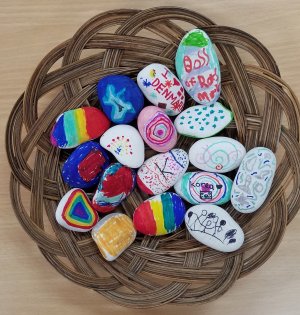Creative Ways to Teach Breathing Practices to Young Learners
Teachers can help students in preschool and the early elementary grades use mindfulness to find calm when they feel overwhelmed.
Your content has been saved!
Go to My Saved Content.Mindfulness is more than just a buzzword—it’s an important well-being practice that has made its way into our schools, and it’s likely here to stay. Practicing mindfulness with students supports strengthened emotion regulation, higher cognitive functioning, and better behavior in school, to name just a few benefits.
One of the central practices of mindfulness meditation is mindfulness of breath. This essentially involves focusing on the act of breathing, either through counting breaths, labeling them with words like “breathing in, breathing out,” or paying attention to the sensations in the body. There’s a reason why you may instinctively tell a child to “take deep breaths” when they are scared or overwhelmed. Slowing down the breath can help to reduce stress, and paying attention to how we breathe helps us to become more aware and focused.
Mindful Breathing Activities for Young Learners
Becoming still and focusing inward on the breath has the potential to aid student learning and well-being. The problem with this practice for those of us who teach young children is the word “still.” For many young children, sitting still and paying attention to breathing may seem downright boring. To be effective, it’s important to demonstrate to them that mindfulness is a tool, not a punishment. It’s possible to bring the benefits of breath practice to our younger learners in ways that honor their innate curiosity and creativity.

Belly buddies: When we feel scared or nervous, our breathing is often shallow and quick. Belly breaths help us ensure that air is filling up all the way down to our stomach. Having something tangible is helpful for children to visualize the idea of breath. Making belly buddies is a simple way for this particular type of breathing. Simply give each child a plain rock and invite them to personalize it with decorations.
When each student has their own special belly buddy, they can be invited to lie down with their “buddy” on their stomach and watch it rise up and down as they guide their breath in and out of their belly. This works nicely with some calming music playing as they breathe.
Counting breaths: To create a simple tool to count breaths, children can string beads onto a small pipe cleaner. I usually have them choose five beads to put on, and then we practice sliding one bead each time we count a breath. Breathe in, breathe out, slide. Breathe in, breathe out, slide.

Playing with the breath: There are so many chances to invite playfulness into breath exploration. Years ago, I invested in beautiful breathing cards. From Spider-Man breathing to rainbow breathing, they provide suggestions for how to add movement and role-play into a simple breathing exercise. Once my students have explored many different types of breaths, I offer them a chance to create their own.
They always come up with a whole deck of new breathing cards that we can use together in class! You could also sign up to get free resources and ideas for some thematic breathing exercises to include in your students’ brain breaks.
Another great way to be playful with the breath is to bring in bubbles and feathers (while being mindful of pandemic protocols). What happens when you blow bubbles with a big, deep breath versus a short, quick breath? What’s the best breath to keep a feather in the air? Or to make it travel farther?
Artistic representations of breath: Ask your students, “What does breathing look like?” and invite them to represent their ideas with watercolors, pastels, loose parts, or other intelligent materials. You’ll be amazed at the richness that emerges as children have the time to explore their ideas with materials. In my class, we always follow with a reflective conversation afterward for children to be able to share their story of breathing.

Glitter jars: Fun to make and more fun to play with, glitter jars are introduced in the warm and friendly book Moody Cow Meditates. When children shake the glitter jar, you can discuss how it represents the busyness of all the thoughts and emotions in your brain. As they breathe slowly, they can watch and feel how both the glitter and their thoughts settle. These jars are a visual reminder of how taking time to focus on breathing can help us to feel calmer in our brains and bodies. The book contains a recipe, but here’s another simple one.
Your turn: These joyful mindful breathing practices will not only be fun for your students but also help them to cultivate the benefits of mindfulness. But these practices will be more impactful when your students know that they are meaningful for their teachers. Those same benefits that mindful breathing brings to students are also present for us as educators. For a chance to be more present, reduce stress and burnout, and feel more compassion, it all starts with the breath. There are also some wonderful apps to help you get started on your journey.
